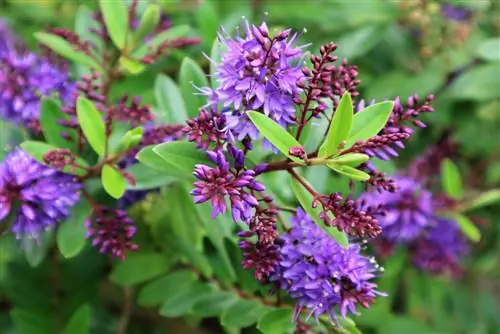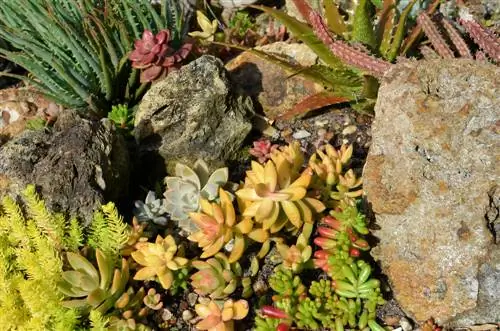- Author admin [email protected].
- Public 2023-12-25 17:45.
- Last modified 2025-01-23 11:21.
Shrub veronicas have some advantages. They tolerate s alty air in coastal areas and can be cultivated in regions with frosty winter months. When planting, you should consider the special requirements of the plant so that cultivation is successful.

What properties does the shrub veronica have?
Shrub veronicas are evergreen shrubs that come in different heights and leaf shapes. They are suitable for providing structure and bordering beds and require a partially shaded location with well-drained, acidic soil. Their flowers provide food for butterflies and they are sensitive to frost but non-toxic.
Origin
The shrub veronica was formerly included in the genus Hebe. It now belongs to the Veronica species and has the Latin name Veronica subgen. Hebe. The original distribution area of the plant group is New Zealand, where it is the largest plant genus on the island with around 90 species. Further occurrences exist in French Polynesia and the Falkland Islands. Some species also occur wild in South America. The plants grow both on the coast and in alpine regions.
Growth
The Veronica species grow as evergreen shrubs whose shoot axes become woody with age. There are dwarf shrubs with heights between 15 and 40 centimeters and carpet-forming species. Some plants develop shrubby and upright forms. They grow up to 150 centimeters high. Other shrub veronica species grow tree-shaped and reach heights of up to seven meters.
leaves
The foliage is arranged in pairs so that two leaves face each other. The pairs of leaves sit opposite each other on the stem. Viewed from above, two rows of leaves standing at right angles to each other can be seen.
There are large-leaved species that occur on coasts, forest edges and lowlands. As altitude increases, the leaves become smaller and smaller. In alpine vegetation belts above the tree line, hebes form leaves that are reduced to leathery scales. Its shape is reminiscent of a whip cord.
The color range of the lanceolate leaves ranges from dark to light green with a shiny top. There are now numerous cultivated forms with brightly colored or variegated foliage. Some varieties have green leaves with yellow or white edges. They are reminiscent of the foliage of spindle bushes.
Bloom
The flower crown is made up of four unequally shaped petals. In the center there are two stamens and a long style. The individual flowers cluster together to form a candle-shaped inflorescence that tapers towards the tip. The inflorescence looks prickly from a distance.
The crown is reminiscent of the delicate flowers of the speedwell species. Shrub veronicas bloom in autumn or summer. Many small-leaved species begin flower development as early as May. During the summer months the species are important food sources for butterflies. Autumn-flowering plants are predominantly large-leaved. Hybrids of Veronica andersonii make up the majority of this group. These cultivated forms develop flower clusters up to 15 centimeters long.
The range of colors is wide. While the natural species develop fine pink or violet flowers, cultivated forms shine in white, red or blue-violet. In the flowerless state, a clear identification of the natural species is almost impossible, as the species are very similar in their growth habit.
Usage
Lifts are popular structure providers that set colorful accents all year round with their rich green. They serve as a bed border and emphasize the garden in winter. The plants are often used as ground cover on graves. Their colorful foliage makes them attractive eye-catchers in perennial plantings. Due to its demands on the soil, the shrub veronica can be planted in peat beds. Here the shrub harmonizes with heather and sedum, whose flowering periods extend throughout the autumn.
Suitable planting partners are:
- Rhododendrons
- Narrow-leaved laurel rose
- Japanese lavender heather
Is shrub veronica poisonous?
The shrub veronica is one of the harmless ornamental plants. It contains no toxic ingredients and can be planted in gardens where there are children or pets.read more
Which location is suitable?
Lifts prefer high humidity. A location on the east side of a house is ideal because the bushes should be protected from direct sunlight. Here the plants enjoy sun in the morning and shady conditions from midday onwards. This means that it doesn't get too warm for the woody bushes even in summer.
A partially shaded location under light trees is also suitable for cultivation. There are varieties that can tolerate up to three hours of sunshine per day. Varieties with colorful foliage require more light because their leaf color is lost in locations that are too dark. When choosing a location, make sure you choose a place protected from the wind.read more
What soil does the plant need?
Veronica subgen. Preferably dig acidic soil. Provide the substrate with plenty of organic material so that the pH value remains in a low environment. This applies to both garden soil and container substrates. A mixture of humus, peat and sand in equal proportions is ideal.
Make sure the conditions are fresh. The shrubs need good substrate permeability as waterlogging is harmful to them. Before you plant your shrub veronica, you should cover the bottom of the pot and planting hole with shards of pottery. They act as drainage and ensure that the irrigation water can drain away optimally.
Cuttings
Cut off young shoots from a he althy mother plant just below a node. The cuttings should not yet be woody. Use a tool with a sharp blade that you have thoroughly cleaned and disinfected beforehand. Remove the leaves in the lower third of the cutting. This is placed in a planter filled with growing soil up to the leafy section. A nutrient-poor mixture of peat and sand is suitable as a substrate.
Moisten the soil and place a glass over the container. Place the pot in a moderately bright location and ensure that the soil temperature does not fall below 20 degrees Celsius.
As soon as fresh leaves develop, the cuttings are ready for repotting. They can then be planted in a nutrient-rich substrate or placed outdoors. During the growth phase, you can regularly clip off some of the shoot tips with your fingernail. Thanks to this measure, the shrub veronica grows bushier.
Shrub veronica in a pot
Shrub veronica species are suitable for planting in containers. Choose a sufficiently large container so that the roots can develop optimally. As soon as the substrate is completely rooted, the plants need a larger container. A clay pot is ideal for planting because the porous material absorbs moisture. There is no regulation of substrate moisture in plastic pots. With these models you also have to pay attention to good water drainage.
The shrubs can be combined with other plants in balcony boxes. High sedum, lantern flowers or pennisetum grass are suitable as planting partners.
Watering shrub veronica
The water requirement for these species is high during the growth phase. Water generously between spring and autumn. On very hot days, you should check the moisture in the soil several times a day and water more often if necessary. Shrub veronica tolerates neither heat in the air nor dryness in the substrate. A lack of water can cause the leaves to turn yellow. Spray with water to support the plant's vitality.
When watering, you should make sure that the water does not pool on the surface. Water enough to avoid surface puddles. The soil must completely absorb the water. Allow the soil to dry thoroughly between waterings, but avoid drying out completely.
As evergreen plants, their metabolism does not go into dormancy even in winter. This means that shrub veronicas need moisture all year round. Water your shrubs on frost-free days. The root ball should not dry out. A thick layer of mulch ensures that the soil does not freeze or dry out.
Fertilize shrub veronica properly
When the growing season begins in spring, mature trees enjoy fertilization. Young plants only need additional nutrients from the second year onwards. Give the plants nutrients every 14 days in the form of a liquid fertilizer (€18.00 on Amazon), which is administered with the irrigation water. A weak dosage is sufficient, as the trees are not heavy feeders.
cut shrub veronica correctly
Heads generally do not need to be cut. They are naturally compact and maintain their growth habit over a long period of time. If the withered inflorescences look unsightly, they can be specifically cut off.
As the bushes get older, they become bare from the bottom up. This is a natural process as the upper shoots take away light from the lower branches. To counteract this process, you should shorten the tips slightly or thin out the plant slightly. This gives the lower part of the plant more light again so that fresh leaves can sprout here. Aim for an oval shape so that the entire plant receives adequate light.
How do I transplant correctly?
If the plant needs a different location, you can generously cut and dig up the root ball in spring. Before taking this measure, it is advisable to cut off bare and withered shoots and shorten the shrub slightly overall. Also cut back the roots so that there is a balanced ratio between leaf mass and root ball.
Repotting
Every two to three years, potted plants are transplanted into a larger container. This measure is necessary at the latest when the roots hit the inside of the pot or grow out of the drainage hole. Choose an overcast day in late spring when temperatures are mild.
The new bucket should be about two to four centimeters larger in circumference. If you skip several sizes at once, the roots will initially spread very quickly and the fresh leaf shoots will take a long time. Completely remove the old substrate to prevent pathogen and pest infestation. You can also rinse the roots with water to remove residue.
Wintering
Shrub veronicas have a certain sensitivity to frost, although they are often offered as hardy. This sensitivity relates to the foliage, which also loses moisture in winter. If the ground is frozen, the plants cannot maintain their water balance. As a result, they dry out. Make sure you have a protected location where there is no direct sunlight in winter. Wind also contributes to excessive evaporation.
In snow-free winter months, cover the plant with garden fleece or brushwood. This protects both large-leaved and small-leaved trees from the dangerous frosts. Potted plants spend the cold months in mild winter quarters. Place the container in an unheated and bright room. Temperatures around ten degrees Celsius and moderately high humidity are ideal.read more
Pests
The typical pests on shrub veronicas settle on leaves and shoots and suck the plant sap out of the veins with their mouthparts.
Spider mites
These pests are common. They leave bright dots on the leaves. In the late infestation stage, the foliage has light gray to bronze spots. The leaves curl and wither until they eventually fall off. Spider mites prefer to spread in spring and leave a fine web on the parts of the plant. Remove the affected leaves and treat the plant with insecticides made from rapeseed oil.
Aphids
They are among the common pests on shrub veronicas. Aphids leave a sticky secretion on the leaves and twigs. A typical damage pattern is curled, heavily curled and sometimes blistered leaves. The pests settle on the undersides of the leaves and are visible as black dots.
Appropriate relief measures:
- Spray the plant with a sharp jet of water
- spray with soap solution
- spray with tansy and nettle extracts
- Apply beneficial insects such as gall mites and lacewings
Scale insects
These pests can be recognized by their shield-shaped body, which protects the insects like a capsule. Only the female scale insects eat and leave unusable remains in the form of sticky secretions that coat the leaves and crust over time. A severe infestation stunts growth and causes the plant to become crippled. If your tree is affected, you should spray all parts of the plant with oil preparations that contain paraffin or rapeseed oil. A continuous oil film forms so that the pests suffocate.
Fungal infestation
Botrytis cinerea is one of the harmful fungi that often colonizes shrub veronicas. They leave a velvety coating with a mouse-gray color on the plant parts. The mushroom lawn creates a lot of dust and in this way releases numerous spores. Gray mold prefers to spread in moist and warm conditions.
Good ventilation of the plant helps preventively. Give the bushes a tonic. An extract from horsetail has proven successful here. Alternatively, the administration of rock dust is recommended. Remove all affected plant parts and treat severely infected plants with an approved fungicide.
Tip
On the balcony, the shrub veronica between insect hotels and rustic garden furniture creates a summery flair. The intense colors are not only decoration but also the perfect background for photo opportunities with homemade jams and juices. This colorful sight makes you want to socialize.
Varieties
- Green Globe: Hardy down to -5° C. Compact growth, uniform spherical shape. Grows between 20 and 30 centimeters high.
- New Zealand: Small-leaved, yellow-green foliage. Growth height 100 to 150 centimeters.
- Variegata: Leaves white-green with yellow, silver-gray spots. Blooms in light purple from July. Up to 180 centimeters high.
- James Stirling: Small needle-shaped leaves, green with a golden yellow tint. Up to 20 centimeters high.






